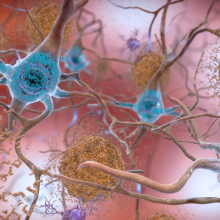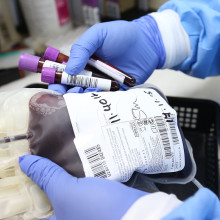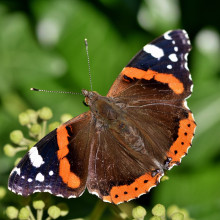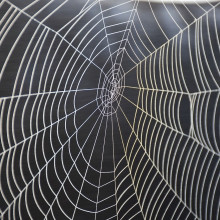- Podcasts
- The Naked Scientists
- Alzheimer’s treatment shelved, and UK’s new spy satellite
Plus, coated blood cells prolongs donation shelf life and may make mixed group transfusions possible…
In this edition of The Naked Scientists: the regulator says the Alzheimer’s drug lecanemab is safe, but NICE say we can’t afford it; also, the UK MOD launches its first Earth-imaging satellite. We talk to the makers; and the BBC’s Frank Gardner on why the UK’s butterflies need our help…

Alzheimer’s drug deemed too costly by UK health service
The new Alzheimer’s drug lecanemab, which can slow the progression of the disease, has been approved by the UK regulator, the MHRA. But it won’t be available to patients on the NHS in England because the National Institute for Clinical Excellence, NICE, which weighs up the cost-effectiveness and economics of healthcare interventions says the benefits “are too small to justify the costs”. Sir John Hardy is the chair of molecular biology of neurological disease at the UCL Institute of Neurology and a leading expert on Alzheimer’s…
John – Lecanemab is an antibody which binds to amyloid. Amyloid is a protein that builds up in the brain and when this lecanemab is injected into the bloodstream, it binds to the amyloid and basically sucks the amyloid out of the brain and that slows the dementia process.
Chris – And to what extent can it do that? What do the trial data that we have so far suggest is being achieved?
John – It suggests it slows the disease by about 25%. Very typically an Alzheimer’s patient will go about seven years from diagnosis to death. This will improve that to be about nine years. It’s a real improvement, but as those figures show, it doesn’t stop the disease.
Chris – How did we arrive at those findings? As in, who was studied, and at what stage of the disease? Because some people always criticise disease interventions on the grounds that we started too late after the horse has already bolted. Could that be a consideration here?
John – That is a consideration. By the time somebody is diagnosed with Alzheimer’s disease, often they are three or four years into the disease process. By that stage they’ve got a huge amount of amyloid in their brain. Also, a lot of damage has started, and just taking the amyloid away at that late stage of disease may not give the full clinical benefit that you would get if you could catch the disease earlier. In almost every disease you can think of, it’s worth starting to treat the disease early in the disease process rather than late.
Chris – Are we in a position to make Alzheimer’s diagnoses earlier, though? At the moment we’re doing this clinically, aren’t we? People notice that there might be a memory problem creeping in, they notice a behavioural change in a close relative, for example, they’ll then get assessed. By then, they’re already manifesting the disease, they already have some of the changes you just outlined. Are we in a position to move that diagnostic window forward though?
John – Yes, we are. In a few special cases we can already do that quite well in, for example, the cases of people who carry the rare mutations which cause the disease. In those families, we can really get better at very early, in fact, presymptomatic diagnosis. In the general population, it’s possible, but it’s difficult. We don’t do blood studies routinely for dementia markers, which we are moving towards but haven’t yet achieved to try and pick up the disease earlier. But those are quite tricky scientifically and very difficult at the moment, organisationally, within the NHS.
Chris – The medicines and healthcare products regulatory agency have given this the nod on the basis of the trials we’ve done. There were some side effects, but the National Institute for Clinical Excellence, whose job it is to sanction the cost effectiveness of interventions, they haven’t given this the thumbs up. They have said in their words, the outcomes are too small to justify the costs. It’s about 20,000 pounds a year per person. Where does this leave us, then, in terms of using these agents?
John – Well, frankly, it leaves us in a bit of a mess. I’m sure we’re going to have GoFundMe campaigns for people to pay it. It’s obviously going to be, at the moment, a drug for the wealthy, and poorer people are going to not be able to easily get access. It’s going to leave us at the moment in a mess. But I think this is a temporary situation because one of the points that NICE make is that there isn’t enough clinical use data in normal clinical practice. The only data that’s available is clinical trial data, which is quite specialised. I think that over the next year we’ll start to see real clinical data reports, particularly from the US, and that might change NICE’s opinion. I think they leave the door open to reconsider their decision.
Chris – One of the things that’s not often immediately obvious is when you take into account the high care costs of looking after someone with advanced Alzheimer’s disease, 21,000 pounds a year is actually not very much money in those terms. If you can prevent that happening because someone might, for instance, die of something else in the meantime, it might actually translate by spending this money into an overall cost saving.
John – That’s right. That’s, I’m sure, been part of the submission that the drug companies and the Alzheimer charities have made, that this type of health economics is quite complicated because you are measuring NHS costs against family costs in terms of people taking time off to look after their relatives. Yes, as you’ve said, care home costs and the economics of this gets very, very difficult. You are right to bring those things up and I’m sure that’s going to be part of the ongoing argument that is had to try and change this decision.

Silica shells gives donated blood cells a longer shelf life
Krishnaa Mahbubani, University of Cambridge
Blood transfusions save millions of lives. But, until stem cell biologists can find ways to grow replacement blood in a test tube, we’re solely reliant on people generously giving blood. This can only survive on the shelf in storage for a limited time though, and supplies of some rarer blood groups, including precious O negative blood that can be given to anybody, periodically run short. Now a new breakthrough might have found a way to give donated blood a much longer shelf life, and potentially mask existing blood group markers so that the blood could be given to any recipient. The technique works through a process of “silicification” – a word I initially struggled to say – that involves impregnating the cells with silica particles that form a shell around and through them, and make them more robust. The University of Cambridge’s Krishnaa Mahbubani works on similar techniques and I asked her to examine the new research, just published in the journal PNAS…
Krishnaa – This paper looks to explore how we can use a technique known as silicification. It’s basically replacing the outside structure of a cell with silica to try and stabilise and make red blood cells more manageable through different machines and any other longer term effects that they have to go through.
Chris – Is it sort of like sugar coating? When we sugarcoat fruit and you get an outer shell, is it sort of putting a shell around a cell, then?
Krishnaa – Essentially, that’s kind of what it’s trying to do. What they do is they dissolve the calcium carbonate, which is basically part of what makes your cells not too squishy. they dissolve that and replace it with silica and in this case it’s nano silica material. They’re small tiny particles to give it effectively a sugar coated shell.
Chris – Around the outside?
Krishnaa – Not just the outside, but through the entire structure.
Chris – And why do we need to do that?
Krishnaa – Their motivation for this specific paper was looking at using it in systems where we keep, or try and keep, organs outside of the body alive so we can test them, check them, make sure that they’re functional. But equally, the idea was also so that they would have red blood cells that are able to be kept significantly longer than they currently do, or even withstand some of the more stressful situations like freezing, which cells tend not to like particularly.
Chris – What about blood groups? Does that come into the equation as well?
Krishnaa – In this paper what they’ve looked at is the fact that the silica that they put around seems to mask some of these blood group markers. It should effectively turn them all into what is known as a universal cell, so it doesn’t matter what blood group you are.
Chris – Because there’s been a big crisis recently of not having enough blood and they were short of of O negative blood. That’s the universal donor group, isn’t it, you can give that to anybody. This masks what’s normally around the outside of the cell, so in theory you could give group A blood to a group O person.
Krishnaa – That’s the idea, that’s what they think this kind of silicification actually can do, but I’m not sure that they’ve actually fully shown that.
Chris – Tell us first of all how they actually do it.
Krishnaa – What they’ve actually done is something very similar to what we do if we were trying to get all of our dry fruits ready for Christma. I don’t know about you guys, but my grandmother would quite often take lots of dried fruit and then put whiskey and a bit of sherry in, and she’d come in and add some more every couple of weeks. That’s essentially what they do is they take the cells and they slowly add different materials into it over a period of time. In this case it’s about three to six hours. They’re changing the acid levels, so the pH levels change of the solution, and what that does is slowly dissolve out the calcium carbonate and allow these silicon nanoparticles to essentially replace them in the cells.
Chris – Can they see that happening? Have they imaged their cells in order to show that they’ve now got this coating, this silicification?
Krishnaa – They did do lots of different imaging technologies on it. They tried to use scanning electron microscopy and transmission electron microscopy to essentially show that the structure hasn’t changed, but they can’t actively show that the silicon nanoparticles have actively replaced the calcium. What they can show is that these silicon nanoparticles will allow certain fluorescent materials to stick to it and not the calcium particles. They have shown that the silica has gone into the cells, but you and I wouldn’t be able to physically see the particles going in as the process is happening.
Chris – And, critically, do the cells still work in the aftermath?
Krishnaa – That’s the bulk of this paper, is they’ve gone through a series of different tests in order to show whether or not they still function like they should. They’ve compared them to a control set of cells – basically your starting red blood cell material that’s not been stored, that’s not been manipulated – and they tried to show that they do work similarly, not perfectly, but similarly.
Chris – And their lifetime? Because one of the other things that with a red blood cell is it has a certain time it will survive in the body before it dies. Are these cells going to die more quickly because they’ve had this done to them?
Krishnaa – Unfortunately, they haven’t shown the full lifespan within a circulating system. They have tried to put them in animals for about four to six hours and they’ve shown that the animals don’t actively destroy them, which is what our bodies would do if we put foreign cells into it. So, in theory, they have the ability to circulate, but they haven’t actually shown a long term circulation. What they have shown is that these cells have potentially got a longer shelf life. Our blood cells that we collect are stored for up to about six weeks. They’re hoping that these cells would potentially be able to be kept significantly longer than that because they don’t get damaged over time.

UK launches first dedicated Earth-imaging satellite
Phil Allen & Darren Jones, Surrey Satellite Technology Limited
UK Space Command has launched its first dedicated Earth-imaging satellite. It is called TYCHE – named after the Greek goddess of fate and fortune – and the Ministry of Defence says it will help strengthen the UK’s intelligence, surveillance, and reconnaissance capabilities. So what should we know about it? I’ve been speaking with Phil Allen and Darren Jones at Surrey Satellite Technology Limited, which built the new satellite…
Darren – TYCHE is an intelligence surveillance and reconnaissance satellite. What that means in layman’s terms really is using sensors to be able to image the Earth’s surface and monitor what’s going on. TYCHE is the first concept demonstrator that will be part of the future constellation that the MOD wants to launch into space. So it provides pictures and videos as well. And the aim over time is the MOD will build up a whole constellation of similar satellites, some with visible sensors, some with potentially infrared sensors, some with radar sensors.
Chris – I remember when I was little, Darren, my dad telling me about some spy satellites that the US military had put in space and saying, and I’m not sure if it was true, but this could read the headlines on a newspaper from space. What sort of quality of resolution will you be able to see with this?
Darren – TYCHE certainly doesn’t have that level of capability, but tyke has a measure of resolution of around a metre. So it can pick out vehicles, determine what sort of type of vehicle, an aircraft they are, but certainly not down to the ability to read number plates off of cars. It’s worth pointing out that this is the very first satellite that MOD is procuring and the aspiration is to deliver higher resolution spacecraft as well over the coming years.
Chris – Where did the MOD get its eyes in the sky before then, before you came along with this one? What were they using?
Darren – The UK Armed forces have ISR capability for many years, typically from aircraft manned or unmanned aircraft. So this really offers not necessarily replacing that capability, but complimentary capability. You can provide imagery from satellites over areas of the world that you wouldn’t necessarily have access to.
Chris – Phil, you led the engineering on this. How big is it?
Phil – You may have seen that A lot of people have likened it to a washing machine size, which is not entirely unfair. It’s about a metre by a metre by a metre
Chris – As satellites go. Am I forgiven for saying that’s actually on the small side? Because a big GPS satellite, they’re sort of bus sized, some of them, aren’t they? So a washing machine sounds positively small in comparison.
Phil – I think you are dead on the money there. Surrey Satellite Technology was set up with the aim of making small satellites, seeing what we can do there and now we are the world leader in small satellites. TYCHE is smaller but also has a lot of capability behind it. Unfortunately what comes with large bus size satellites is a large bus size price tag and not always a huge amount more in capability.
Chris – What sort of orbit does it occupy? Because there is a range of ways of doing this isn’t there? You can put them so they go over the poles and the planet turns inside the orbit. You get a big view of everything or you can stay in one position relative to the Earth’s surface in a geostationary orbit. So where’s this one gone?
Phil – This one is in a low Earth orbit. So it’s in what’s known as a polar sun synchronous orbit. As you quite rightly said, the world moves underneath and therefore you cover the globe in a number of days. Well what’s special about a sun synchronous orbit is it means that your orbit plane relative to the sun is pretty much constant throughout a year. And that means that unlike some spacecraft that would have large tracking arrays, which are costly and very complicated, we can have arrays that are deployed to a fixed angle. They will always be facing the sun throughout the year.
Chris – These are your solar panels that presumably power it. Can I ask the question then that when you go behind the Earth, the satellite can’t see the sun. So do you have to put some kind of provision in so that it can store enough energy when it can see the sun so it not just powers itself then but has got reserve for when it goes behind Earth and is in the shade?
Phil – That’s correct. So the spacecraft has a large battery, a bit like in your mobile phone, but is much more carefully controlled. There’s a lot of circuitry around to make sure that the battery is in good health. Anyone that’s had a mobile phone or other rechargeable products will know that over time it doesn’t perform as well as you’d like and can’t hold its charge. We can’t afford that for a spacecraft. Anytime that you go into a period of shadow or eclipse as it’s known, then it’s on battery power at that point. And once you come into sunlight, the solar cells start to charge that battery back up.
Chris – Did you have to solve any new or major problems in order to deliver this or is it very much a question of bringing together existing knowledge? Because Surrey Satellites has had form in this game for a long time. I mean you’re one of the world’s leaders in doing this kind of thing, so therefore was it a question of putting bits together you already knew or was there new science in this?
Phil – I would’ve loved to stick bits together already, but no, we had a number of key new components. The two that stick out to me more than any other one that is known as the ACP, the auxiliary computer peripheral, which provides onboard processing capability and the other is the ISL or inter satellite link, which allows us to communicate with the spacecraft when it’s not in direct view of our ground station. Here in Guilford, both products themselves were new and getting an understanding of what the customer wants to use with these, how they work with existing systems, how they work with one another, were all big challenges to overcome on the project, but we are now seeing that they’re working out as expected.
Chris – And can you move it around? Now you’ve put it there, can you change its position? Does it need a boost to put its altitude up periodically? How do you do that sort of thing?
Phil – So there’s a couple of things. The orientation of the satellite itself. So the spacecraft is rotated around using reaction wheels. So these wheels spin up and have a mass on them and there’s what you would conventionally think there’d be one per axis, but there’s actually four in each, are in two axes. So that if any one of them were to fail, you could still rotate things around and a lot of spaces about working out if something goes wrong, how can you carry on? And this will allow you to track targets as you go over to take images with. It also allows you to track the ground station when you are downlinking your data. But in regards to orbit manoeuvre, the spacecraft has a water propulsion system and this allows us to raise or lower our orbit if we were to have to avoid space debris, for example. A spacecraft even as high as TYCHE is still subject to atmospheric drag, which will reduce its orbit height over time because it slows it down. And so we can use the propulsion system to raise the spacecraft’s velocity and thus increase its orbit height. Again, back to its operational orbit.

British butterfly numbers plummet in 2024
Frank Gardner, BBC
The UK’s butterfly population has declined markedly this year, largely, conservationists speculate, because of a lack of sun and too much rainfall earlier in the year. The charity Butterfly Conservation says that this is part of a worrying trend that has seen the numbers of four out of five of our native species decline steadily since the 1970s. To find out more, we put in a call to BBC’s security correspondent who is also, as it turns out, a butterfly authority and enthusiast: Frank Gardner…
Frank – It’s been a pretty miserable disappointing year for butterflies in the uk. On the whole, the numbers are down and the number of species that people are seeing generally I think are down. In my case, I have only seen 21 species out of the 59 resident species, approximately, that we have in this country. Last year I saw 34. There are plenty of people who’ve spent a lot more time than this than me that will see a great deal, many more than that. But there are some species that I never saw. Orange tip this year for example, which I’ve always seen in previous years. I haven’t seen small copper. Particularly absent has been small tortoiseshell, they’ve been declining really since 2000. And they’ve got a particular problem I’m told, which is that they suffer from a parasite called Sturmia bella, which came over from France around the turn of the century in 1999. And that lays its eggs quite close to the caterpillars, which then eat them along with the leaves. And that really damages the numbers.
Chris – Is it the same sort of story for the others that are down on numbers and they’ve also got some kind of parasite challenging them or is it a range of factors or is this just a one off?
Frank – It’s a range of factors. It’s been a very wet spring and that has affected, well, it’s affected the leaves because they don’t like damp. Wet leaves, habitat loss, habitat fragmentation, climate change, associated change in weather and pesticide use. There are a couple of species that have done better this year. Brimstone and holly blue and they, I’m told, are coming over from Europe, from the continent. One of the mysteries is a species called black veined white, which we saw photographed on the outskirts of London last year. And we still don’t know exactly where they appeared because they’ve been extubated, i.e. vanished, from the UK since 1925. This is the first sighting of them in a hundred years. They’re very common on the constant. They occur in Calais, but they haven’t been here for a long time. And the suspicion was that somebody had done an unauthorised release, but locals in the area, and they saw about 30 altogether, are convinced that a female flew over from France, laid her eggs on the hawthorn, on blackthorn bushes. And they hatched out last year. And they’d been seen again this year early in the summer in May, June.
Chris – One good news story I suppose. But whenever there is a loss of one species, there are almost always knock-on consequences. There are migratory birds that arrive hoping there’s going to be caterpillars to feast on. If the butterflies don’t have sufficient numbers, then that means birds go unfed, which means that they then see a decline as well. So it’s sort of a domino effect, isn’t it?
Frank – It really is the whole sort of cycle. The food chain is very much susceptible to changes in weather and in habitat. So one of the reasons why we have fewer butterflies is also because there’s not as much habitat for them. As cities grow, as open, wild spaces are taken up with urban development.
Chris – Presumably, a lot of those factors are not easy to reverse quickly. Are there any sort of practical things that we can do to at least try and slow down the decline, if not, stop it.?
Frank – Wild spaces is important and not disturbing those habitats, letting them just get on with it. The figures that Butterfly Conservation, the UK charity, have a pretty depressing, they’re saying that since the 1970s, 80% of butterfly species in the UK have declined. And they were saying for those of us aged about 40 or above. We’ll remember seeing a lot more butterflies around where we were children than now.

What makes spider silk feel so weird?
Thanks to Sara Goodacre for the answer!
James – Is there something about spider silk that is particularly unappealing to humans, or could it just be our general aversion to arachnids? Sara Goodacre is a professor of biology at the University of Nottingham where she runs the spider lab.
Sara – Well, the first thing to say really is that spiders themselves are a really super old group of animals. I mean really old, like 400 million years old before even insects, nevermind the dinosaurs which are far more recent. This means that all the silks that spiders have are also really ancient and there’s been lots of time for them to evolve to be different from each other. So as people might know, some are sticky, some are thick fibres, and some are incredibly fine, some are even electrostatic. And all of this difference likely matters when it comes to brushing up against a human hand because there might be different reasons for the weird feeling that the human gets. But notwithstanding this variety amongst spiders, the silks are actually all so really different molecularly to any other proteins, really. Any other silks, for example, that are made by silkworms. The closest thing, but it’s still not very close, is the glue that sticks a limpet to a rock.
James – So James, that special sort of stickiness is potentially part of the weirdness you’re experiencing. You’re touching something very special and unique in terms of the molecules themselves, but just because it is unique, does that mean the touch of spider’s? Silk is necessarily disconcerting. So
Sara – I guess any physical sensation you get from touching whatever the spider silk is, whatever the cobweb is, is due to the silk touching hairs on our skin, which we then feel, and silk and cobwebs tend to be really hydrophobic, and that means they move away from water. So they sort of tend to react like a piece of very dried, fluffed up cotton wool. And that in itself might be a slightly weird feeling. Personally, I can say I don’t find cobwebs or spiders weird, and that might be because I’m used to them or because I’m not frightened of spiders. They’re really part of my day job as I run a spider lab. Or it could even be that I perceive the sensation differently. Perceptions and how we perceive the world around us, as we know, varies amongst people and it’s probably a big factor when it comes to how we at anything feels and when it touches your skin.

